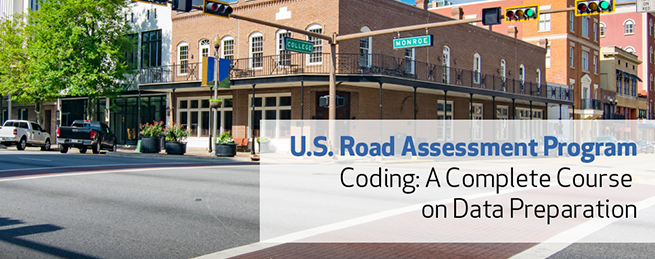usRAP Data Coding: A Complete Course on Data Preparation
 Course Description
Course Description
Pursuing a usRAP project? Coding road attributes from photo/video data is a key first step. usRAP Coding: A Complete Course on Data Preparation is one of a series of courses developed in a partnership with usRAP. This course covers the process of preparing the data that is needed by the ViDA software in order to generate star ratings and safer roads investment plans. Participants will be introduced to the usRAP Coding Manual and coding tool and will be given thorough overviews of the 50+ road attributes analyzed by the usRAP protocols. This course is also appropriate for coding supervisors.
Intended Audience
This course is intended for individuals and/or teams who have been selected to serve as coders on a new or existing usRAP project. Persons who will be supervising coding teams should also take this course and be familiar with its content. There is no prerequisite other than this training course to become a usRAP coder, though some background in traffic engineering or similar field may be advantageous. Coding teams may consist of undergraduate and graduate students, technicians, consultants, or others who have received this training.
Learning Outcomes
Assessments
Course Outline
By the end of the course, you should be able to:
- Recognize the importance of the usRAP star ratings and safer roads investment plans
- Illustrate the major stages in the usRAP data coding and analysis process
- Recall the coding procedures to assure a high level of accuracy in the data
- Find the different roadway attributes in the usRAP Coding Manual
- Assign a specific code and post code to each attribute present in a set of data
There are four assessments within module 5 of the course that you must pass in order to receive PDH (CEU) credits. You must score at least an 80% or above on each assessment to receive credit for the course. You are allowed 3 attempts to pass each assessment, with each attempt having a 1 hour time limitation.
Module 1: Introduction
Module 2: Stages of coding and data processing activities
Module 3: Coding tools and quality control
Module 4: Database structure and definitions
Module 5: Roadway Attributes
- Section 5.1: Coding documentation attributes
- Section 5.2: Location attributes
- Section 5.3: Roadway and cross-section attributes
- Section 5.4: Alignment attributes
Assessment 1- Lanes/shoulders/curvature on an undivided road (Sections 5.3-5.4)
- Section 5.5: Roadside attributes
Assessment 2- Roadside (Section 5.5)
- Section 5.6: Intersection attributes
Assessment 3- Intersection Coding (Section 5.6)
- Section 5.7: Flow attributes
- Section 5.8: Speed attributes
- Section 5.9: Land use/development attributes
- Section 5.10: Vulnerable road user facility attributes
Assessment 4- Pedestrian/bike facilities coding (Section 5.10)
Module 6: Coding data file
Module 7: Post-coding attributes
Module 8: ViDA software
Course Procedures
- The course begins the date we receive your registration. All coursework must be completed within 60 days of that date. Approximate time to complete this course is 6 hours. Once your registration information is received, we will send you your username and password to access the course site.Complete the learning modules at your own pace. For each module, handouts will be available. Upon completion of the assessment and the course, you will need to request a certificate of completion which includes Continuing Education Unit (0.6 CEUs/6 PDHs). The issuing cost of the CEUs is $25. Please request your CEUs through the course site.
Course Materials
You will be provided with a PDF of the Coding Manual, video presentations, learning activities, and PDF handouts. This course has no additional textbook aside from the Coding Manual.
Contact Information
Contact isopd@iastate.edu for more information.
Continuing Education Units (CEUs): 0.75 CEUs (7.5 PDHs)
Registration Cost: Waived by RSF (reg. $1,200)
Course Hours: 7.5 hours
Course Start Date: Upon Registration
Course Access Time: 30 Days
Instructor
 Zachary Hans, P.E.
Zachary Hans, P.E.
Senior research engineer at the Center for Transportation Research and Education (CTRE)
Zach has over two decades of professional experience in transportation engineering, working primarily in the areas of safety, maintenance operations, asset management, and planning. Zach has supported usRAP since its inception and participated in several iRAP efforts. Zach also serves as a Director of the Center for Weather Impacts on Mobility and Safety (CWIMS) at the Institute for Transportation (InTrans) at Iowa State University.
Public & State Agencies Utilizing usRAP
- Florida DOT
- Illinois DOT
- Iowa DOT
- Kentucky Transportation Cabinet (KTC)
- Michigan DOT
- New Jersey DOT
- New Mexico DOT
- Utah DOT
Learn more about these agencies’ projects and research with usRAP

I have been involved in road safety for more than 20 years, working all around the world. I have to admit that the usRAP Data Coding: A Complete Course on Data Preparation was the best I’ve participated in so far.
Stelios Efstathiadis
